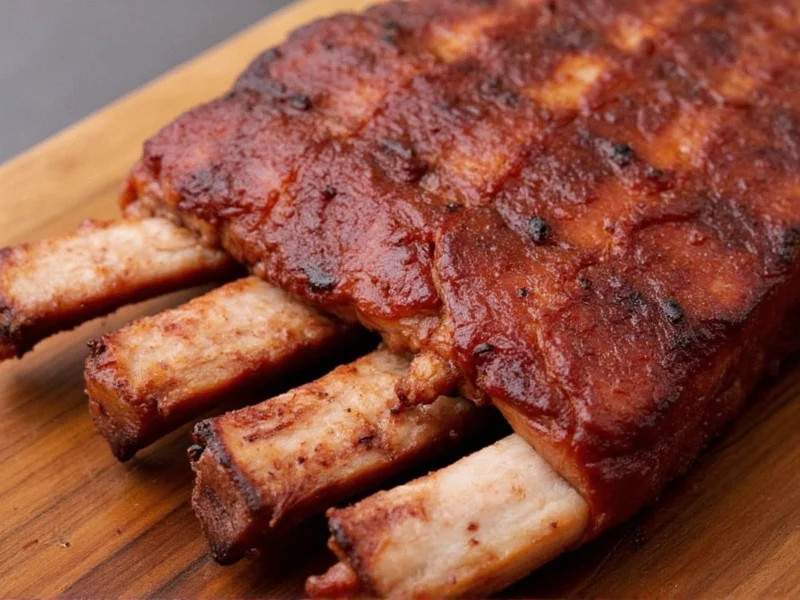Understanding the proper temperature for ribs separates satisfactory barbecue from exceptional results. While food safety standards provide minimum thresholds, achieving that perfect balance of safety and texture requires knowledge beyond basic guidelines. This comprehensive guide explores the science behind rib temperatures, helping you consistently produce restaurant-quality results at home.
The Science Behind Rib Temperatures
Rib cooking involves two critical temperature considerations: food safety and texture development. The USDA's minimum safe temperature of 145°F (63°C) eliminates harmful bacteria, but connective tissues like collagen require much higher temperatures to transform into gelatin—the process that creates that coveted fall-off-the-bone tenderness.
Collagen begins breaking down around 160°F (71°C) but doesn't fully convert to gelatin until reaching 190-205°F (88-96°C). This explains why ribs cooked only to the minimum safe temperature often remain tough despite being technically safe to eat.
Rib Temperature Guidelines by Type
Different rib varieties require specific temperature approaches due to variations in fat content, bone structure, and connective tissue.
| Rib Type | USDA Minimum Safe Temp | Ideal Eating Temp | Texture Characteristics |
|---|---|---|---|
| Baby Back Ribs | 145°F (63°C) | 190-203°F (88-95°C) | Tender with slight chew, meat pulls cleanly from bone |
| Spare Ribs | 145°F (63°C) | 195-205°F (90-96°C) | Fall-off-the-bone tender, slightly sticky texture |
| St. Louis Cut | 145°F (63°C) | 192-200°F (89-93°C) | Balanced tenderness with structural integrity |
| Beef Back Ribs | 145°F (63°C) | 200-205°F (93-96°C) | Rich, meaty texture with tender connective tissues |
Temperature Requirements by Cooking Method
The cooking technique significantly impacts ideal finishing temperatures. Low-and-slow methods like smoking allow more time for collagen breakdown at lower temperatures, while faster methods may require slightly higher final temperatures.
Smoking Ribs Temperature Guide
When smoking ribs at 225-250°F (107-121°C), target these temperature milestones:
- The Stall (150-170°F): Evaporative cooling causes temperature plateau—be patient
- Wrap Point (165-175°F): Consider wrapping in butcher paper or foil to push through the stall
- Final Pull (190-205°F): Remove when probe-tender, not strictly by temperature
Grilling and Oven Methods
Higher-heat methods require careful monitoring as ribs can overcook quickly. For direct grilling:
- Start with indirect heat until reaching 160°F
- Finish with brief direct heat for caramelization
- Pull at 185-195°F to prevent drying out
Proper Temperature Measurement Techniques
Accurate temperature readings require proper thermometer use:
- Thermometer type: Use an instant-read or leave-in probe thermometer with at least ±1°F accuracy
- Insertion point: Measure in the thickest part between bones, avoiding contact with bone
- Multiple readings: Check several spots as temperature can vary across the rack
- Final verification: Perform the bend test or twist test in addition to temperature checks
The bend test involves lifting the rack from one end—when properly cooked, it should bend significantly with cracks forming on the surface. The twist test checks if a bone twists out easily with slight pressure.
Resting Ribs: The Critical Final Step
Always allow ribs to rest for 10-15 minutes after reaching target temperature. This crucial step:
- Allows juices to redistribute throughout the meat
- Enables residual cooking to complete the tenderization process
- Prevents juice loss when cutting
- Results in more consistent texture from end to end
Common Temperature Mistakes to Avoid
Even experienced cooks make these temperature-related errors:
- Trusting timers over thermometers: Cooking times vary significantly based on equipment and conditions
- Measuring near bones: Bone contact gives falsely high readings
- Ignoring ambient conditions: Wind, humidity, and temperature affect cooking times
- Pulling too early: Ribs between 180-185°F often lack sufficient tenderness
- Overcooking: Temperatures exceeding 205°F can cause ribs to become mushy
Visual and Tactile Doneness Indicators
While temperature provides objective measurement, these sensory cues confirm perfect doneness:
- Meat retraction: Meat should pull back 1/4 to 1/2 inch from bone ends
- Probe tenderness: A toothpick should slide in with little resistance
- Surface appearance: Bark should be set with slight cracking
- Flexibility: Rack should bend easily without breaking
Temperature provides the foundation for perfectly cooked ribs, but combining thermometer readings with these physical indicators ensures consistent success. Remember that ideal rib temperature serves as a guideline—the probe test ultimately determines doneness.











 浙公网安备
33010002000092号
浙公网安备
33010002000092号 浙B2-20120091-4
浙B2-20120091-4